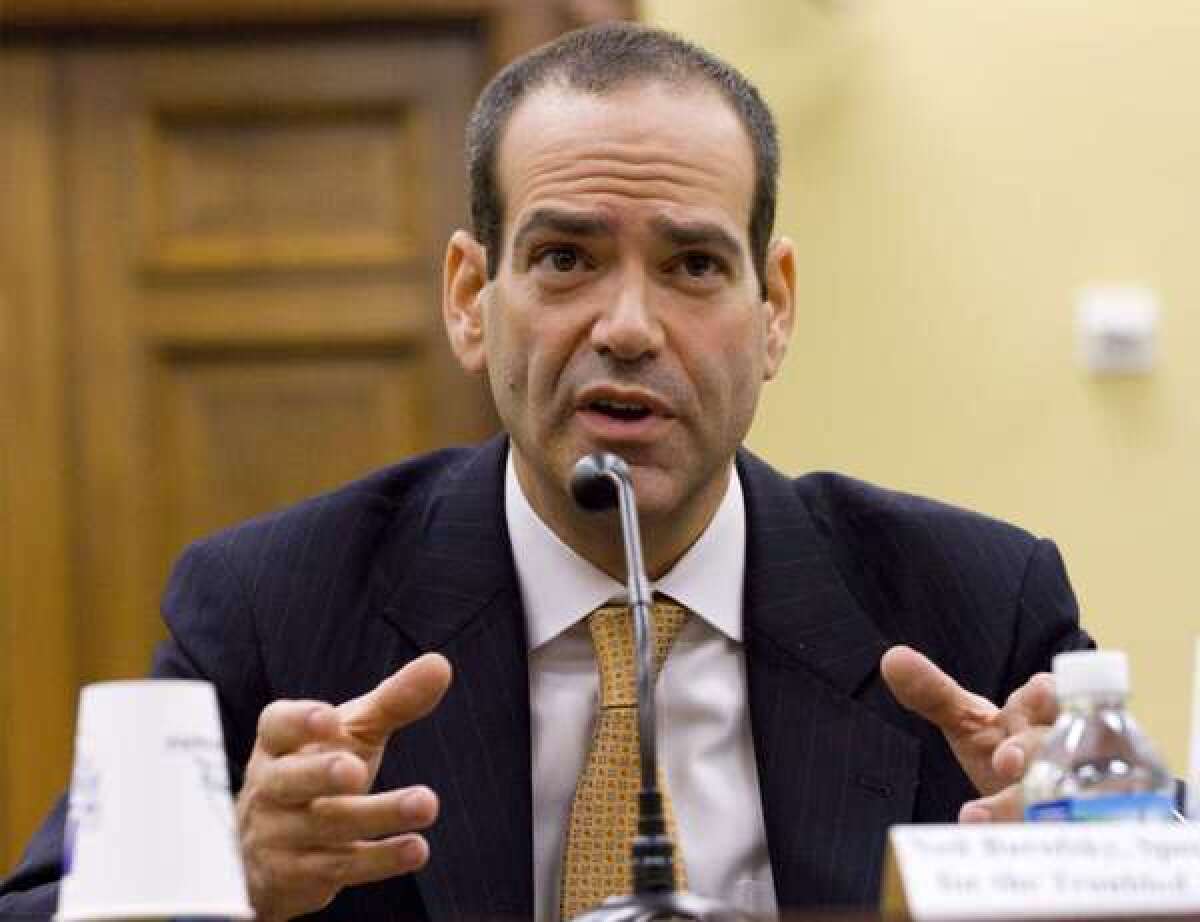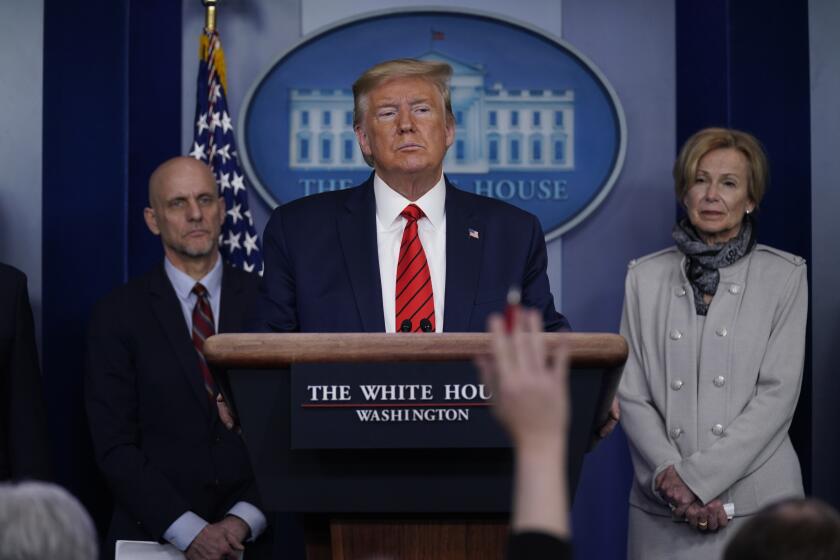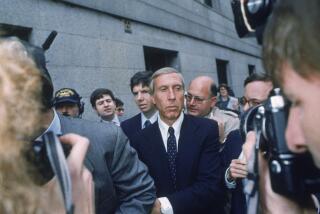Column: The failures of the last bailout should alarm us about the coronavirus bailout

- Share via
“‘Sunlight is the best disinfectant,’ Justice Brandeis said,” Neil M. Barofsky is telling me. “That’s never been more true.”
We’re talking about the conditions — lack of conditions, to be precise — attached to the $500-billion bailout of American corporations being pondered by Congress this week as an antidote to the vast shutdown of the U.S. economy resulting from the coronacrisis.
Barofsky is an expert in how a massive corporate bailout should be managed to ensure that its stated goals are met. That’s because he had a front-row seat for the last bailout, a $700-billion bank rescue program enacted in 2008 in the teeth of the financial crisis.
You run a very significant risk that rather than preserve jobs, the money is going to flow right through the company and into the pockets of shareholders.
— Former bailout overseer Neil M. Barofsky
Then a federal prosecutor in New York, Barofsky was appointed by President George W. Bush that year to oversee the bank bailout, formally known as the Troubled Assets Relief Program, or TARP. His title was special inspector general, which made his office SIGTARP. (He’s now an attorney at the firm Jenner & Block.)
The chief insight Barofsky drew from that experience is this: “If you’re going to distribute the money without conditions attached, at least incentives or penalties, your policy goals are not going to be achieved.”
That’s germane to the current debate because the ostensible goal of the $500-billion bailout is to enable its corporate recipients to preserve jobs.
Yet the proposal originally advanced by Senate Republicans would have weak or even nonexistent oversight, or mandates that companies spend the money on their workforce. Much of the cash would be disbursed at the discretion of Treasury Secretary Steven T. Mnuchin, with the recipients not even disclosed until six months after they’re funded.
When calamity strikes — especially avoidable calamity — the human instinct is to look for the silver lining, often by calling the event a “teachable moment.”
Congressional negotiators were reportedly working on an oversight mechanism late Monday, but the details were still in flux early Tuesday.
“The idea that we’re going to do this without transparency, without recipients being disclosed, and without any effective and strong and independent oversight mechanism,” Barosky says, “is sheer madness, in my view.”
(Barofsky’s paraphrase of Louis D. Brandeis comes from the book “Other People’s Money,” an investigation of the Gilded Age financial industry that Brandeis first published as a series of articles in 1913, three years before he joined the Supreme Court.)
Even with legally binding oversight, the 2008 bailout failed to achieve its stated goals, which were to jump-start bank lending, especially to small business and home buyers, and to protect homeowners from foreclosure.
Those promises were made by the bailout’s supporters to get the program through Congress, Barofsky recalls. But the money was disbursed without any conditions imposed to ensure that that happened.
As a result, the banks did everything but. To this day, Barofsky says, the published goals have not been met — “not even close.”
By 2010, then-Treasury Secretary Timothy Geithner was even acknowledging that the real, unstated goal of TARP had been not to avert foreclosures of distressed homeowners, but to enable the banks to handle the tide of coming foreclosures more efficiently. The program would “foam the runway” for the banks by stretching out foreclosures, Geithner said. Thus, in Barofsky’s words, “giving the banks more time to absorb losses while … the bailouts juiced bank profits.”
Even though Congress had invested SIGTARP with explicit statutory authority to obtain information about how the U.S. Treasury was disbursing the bailout bounty to banks, Barofsky’s appointment thrust him into more than two years of battling with treasury officials and bankers to obtain information about their actions.
The treasury made deals with major financial institutions behind Barofsky’s back, often misleading him about its plans. He faced constant attacks from government officials and bankers, including whispering campaigns aimed (unsuccessfully) at driving a wedge between SIGTARP and its most important supporters in Congress, including Rep. Barney Frank, D-Mass., and Elizabeth Warren, then a member of the bailout’s Congressional Oversight Panel but not yet a U.S. Senator.
President Trump, Elon Musk and other are spreading dangerous myths about coronavirus.
Barofsky wrote in his 2012 memoir, “Bailout,” of his dismay at “the duplicitous nature of the world I now inhabited.”
The most disturbing case of deceit concerned the giant insurance company AIG, which had received a $170-billion bailout to keep it from collapsing, which experts feared could have precipitated a global financial meltdown.
Although the government bailout limited bonus payments to executives, AIG used a loophole to pay $168 million in “retention bonuses” to its executives, including those in the AIG division that had brought the company down.
Typically, Barofsky wrote in his book, “I found out about the payments only after the fact. Treasury officials who had authorized the payments were concerned only about the negative publicity, not about the squandering of taxpayer funds.
“The Wall Street fiction that certain financial executives were preternaturally gifted supermen who deserved every penny of their staggering paychecks and bonuses was firmly ingrained in Treasury’s psyche.”
The bonuses were paid.
Barofsky observes that even if his office’s efforts at oversight were resisted and undermined by their targets in government and the banking world, SIGTARP ultimately won almost all its battles for information.
And though oversight didn’t prevent mistakes from being made in administering TARP, “one of the reasons we even know about the mistakes we made last time that could be corrected this time is that we had oversight.
“Without that oversight,” he says, “they would have happened in the dark, and it would have been far, far worse. Some of the mistakes were corrected, and others never happened because of the transparency” that SIGTARP brought to the process.
The 2008 bailout teaches that without imposing conditions and establishing strong oversight and enforcement, companies will do what comes naturally — which is not necessarily to save their workforce.
In recent days, alarm about the economic impact of the novel coronavirus have turned conservatives who weeks ago were boasting about the shrinking of the U.S. government into raving Keynesians, proclaiming the virtues of deficit-financed economic stimulus.
Barofsky is loath to specify what conditions he thinks should be imposed on companies receiving bailouts this time around — except for one, restrictions on using money putatively earmarked for employees to repurchase shares or issue dividends instead.
“If your stated policy goal is around jobs, you can’t reasonably expect to put trillions of dollars of taxpayer money into a system and expect that result, if you’re not willing to take the step of putting those restrictions in place, or putting at least incentives in place, to accomplish those goals,” he says. “Otherwise … you run a very significant risk that rather than preserve jobs, the money is going to flow right through the company and into the pockets of shareholders.”
He also warns against giving government officials broad discretion to funnel money to their chosen beneficiaries, especially without explicit criteria and guidelines.
Through bailouts, he says, “you’re picking winners and losers. Bailouts almost by definition are a perversion of capitalism. They are saying that the normal market forces, even in this incredibly abnormal time, are not going to prevail.
“But the companies that saved the most money and maybe put themselves in the situation to survive this shock are not the only ones that are going to survive … But when you’re taking that heavy burden of disbursing money to save companies, it has to be done on the basis of an objective criterion — not one that is based on who has the most expensive and most persuasive lobbyists. It can’t be who has the greatest political or personal connections to decision-makers.
“The way to combat that is through transparency and oversight,” he says. “This is where the sun has to shine the brightest. There’s got to be a watchdog whose sole job is to make sure this goes right.”
More to Read
Inside the business of entertainment
The Wide Shot brings you news, analysis and insights on everything from streaming wars to production — and what it all means for the future.
You may occasionally receive promotional content from the Los Angeles Times.












